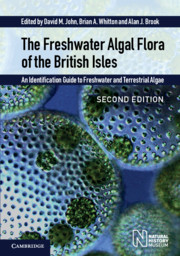 The Freshwater Algal Flora of the British Isles
The Freshwater Algal Flora of the British Isles Published online by Cambridge University Press: 12 January 2024
The green algae or chlorophytes are the most species-rich and morphologically diverse group in the Flora. Traditionally they have been classified into classes and orders according to the level of organization when in the vegetative state. As a consequence, motile forms are traditionally attributed to the order Volocales, coccoids to the Chlorococcales, filamentous forms to the Ulotrichales and Chaetophorales. A new classification was proposed by Mattox and Stewart (1984) based on the ultrastructural architecture of the basal body in flagellated cells and on cytokinesis during mitosis. Species with the basal bodies orientated in a clockwise (CW) or directly opposite (DO) were placed in class Chlorophyceae and those having a counterclockwise orientation in the classes Ulvophyceae and Pleurastrophyceae; the latter was renamed Trebouxiophyceae by Friedl (1995), who redefined it. Another class, the Charophyceae, was recognized by Mattox and Stewart (1984), who distinguished it from the other classes by the presence of a cell plate (phragmoplast) produced during cytokinesis and the subapical insertion of two similar flagella; the multilayered structure at the flagellar base originally used for separation is known now to be present in other classes.
Molecular data have shown that the green algae are separated in two major evolutionary lineages, the Chlorophyta and the Streptophyta. The Chlorophyceae, Trebouxiophyceae and Ulvophyceae belong to the Chlorophyta. The Streptophyta include the land plants and several groups of green algae; whereas in the past these were regarded as orders of the class Charophyceae, at present they are separated at class level: Mesostigmatophyceae, Chlorokybophyceae, Klebsormidiophyceae, Coleochaetophyceae, Zygnemophyceae and Charophyceae (Lewis and McCourt, 2004; Lemieux et al., 2007; Pröschold and Leliaert, 2007; Becker and Marin, 2009). In the Zygnemophyceae, the traditionally recognized order Zygnematales is often divided into the Zygnematales sensu stricto and the Desmidiales (see McCourt et al., 2000; Gontcharov et al., 2003). The classification of the green algae based upon ultrastructural details has received further support from the phylogenetic analysis of nuclear-encoded SSU and ITS rDNA sequences (Pröschold and Leliaert, 2007).
Key to Genera
The key below is divided into sections designed to facilitate the ready identification of the more than 250 chlorophyte genera recorded from the British Isles. The first step is to decide to which section your sample belongs and then to key it out under the appropriate section. Once having arrived at a genus, then compare it against the description and illustrations before using the key to species.
To save this book to your Kindle, first ensure [email protected] is added to your Approved Personal Document E-mail List under your Personal Document Settings on the Manage Your Content and Devices page of your Amazon account. Then enter the ‘name’ part of your Kindle email address below. Find out more about saving to your Kindle.
Note you can select to save to either the @free.kindle.com or @kindle.com variations. ‘@free.kindle.com’ emails are free but can only be saved to your device when it is connected to wi-fi. ‘@kindle.com’ emails can be delivered even when you are not connected to wi-fi, but note that service fees apply.
Find out more about the Kindle Personal Document Service.
To save content items to your account, please confirm that you agree to abide by our usage policies. If this is the first time you use this feature, you will be asked to authorise Cambridge Core to connect with your account. Find out more about saving content to Dropbox.
To save content items to your account, please confirm that you agree to abide by our usage policies. If this is the first time you use this feature, you will be asked to authorise Cambridge Core to connect with your account. Find out more about saving content to Google Drive.